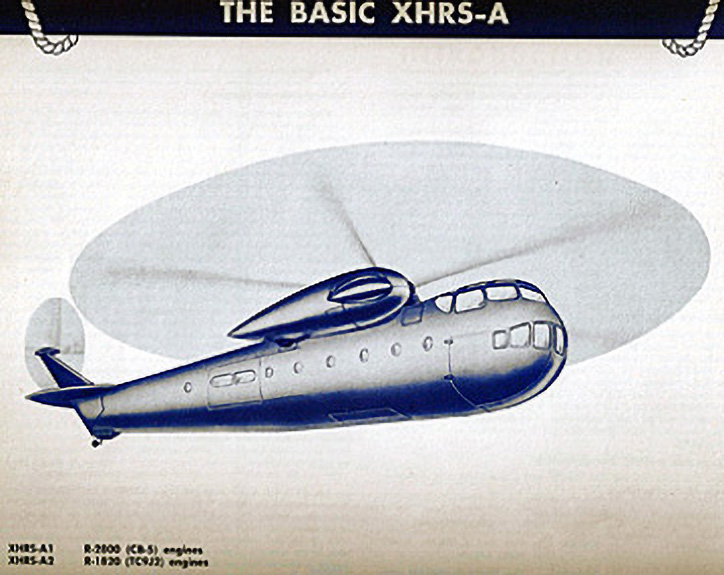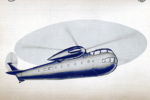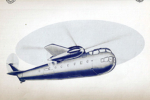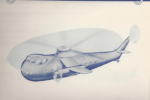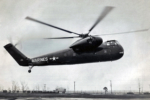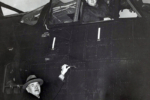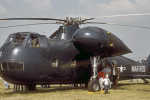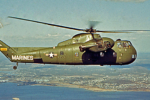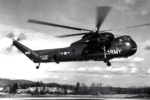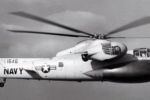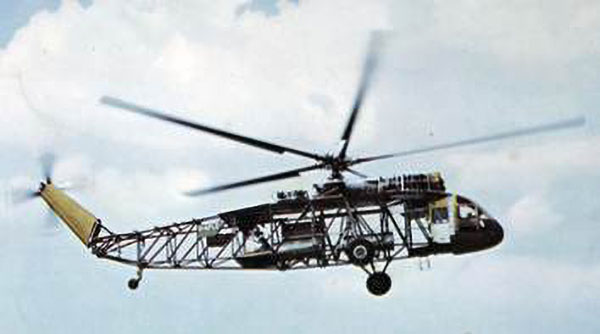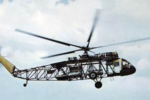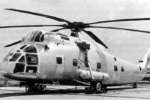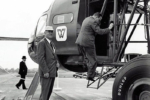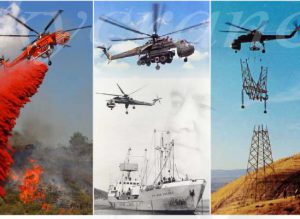Sikorsky Product History
Sikorsky S-56
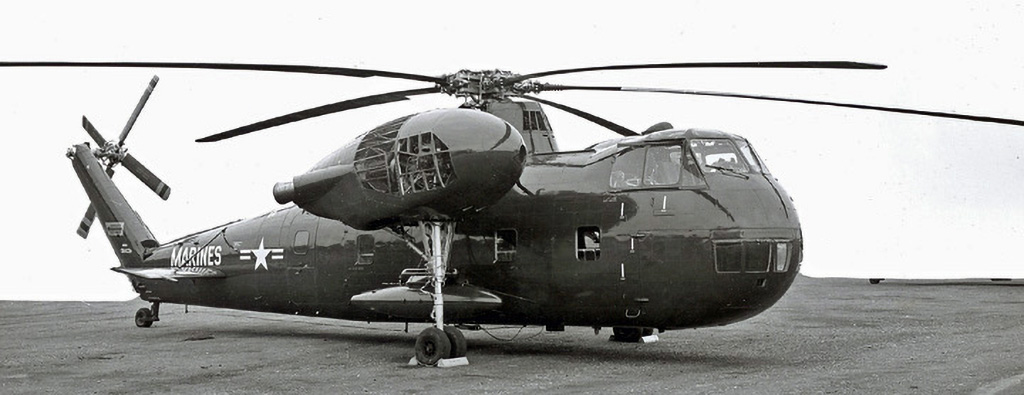
Background
The Sikorsky S-56 helicopter was designed in response to a U. S. Navy Specification dated September 15, 1950 for a Class HR (Assault) Helicopter. A proposal was submitted on December 31, 1950 proposing two designs – a basic helicopter identified as XHRS-A, and a compound helicopter with folding wings identified as XHRS-B. Both models were powered by two Pratt & Whitney R-2800 reciprocating engines however both were offered with Allison XT-38-A-2 turbine engines. The Navy chose the model with the least technical risk and in early 1951 provided a Contract (Experimental Order) for the XHRS-A helicopter giving it the military designation XHR2S-1. First flight of the XHR2S-1 was on December 18, 1953.
Customer | Model No. | Old Model No (Prior to 1962) | Nickname | Mission |
|---|---|---|---|---|
U.S. Marine Corps | CH-37C | HR2S-1 | The Deuce | Utility Transport |
U.S. Navy | HR2S-1W | Airborne Early Warning | ||
U.S. Army | CH-37A | H-37A | Mojave | Utility Transport |
U.S. Army | CH-37B | H-37B | Mojave | Utility Transport |
The U.S. Army “borrowed” an XHR2S-1 helicopter in 1954 for testing designating it as an YH-37. This helicopter did not have an automatic folding main rotor or an Automatic Stabilization System. After a successful test program the Army placed an initial order for 9 helicopters similar to the helicopter tested. The Army eventually purchased 94 CH-37A (H-37A) helicopters. After delivery of the last H-37A helicopter, 90 of the 94 helicopters were returned to Sikorsky for remanufacturing to the H-37B configuration which included moving the stabilizer to the top of the tail rotor pylon, adding Automatic Stabilization Equipment (ASE) to allow instrument flight, and larger engine oil tanks.
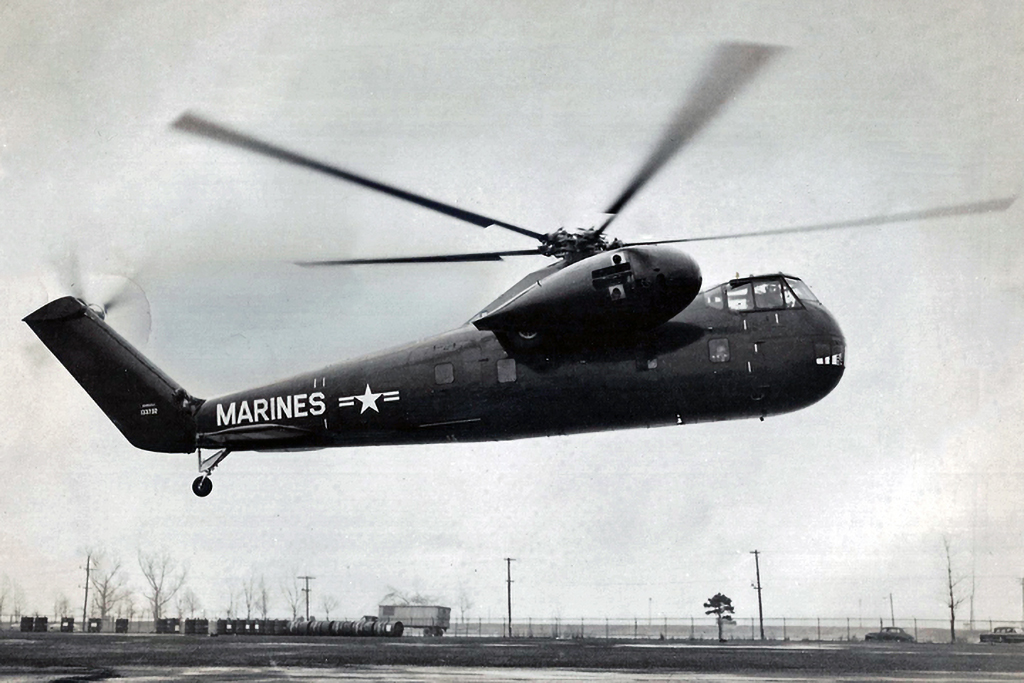 XHR2S-1 BuNo 133732 hovers at Sikorsky Aircraft, Bridgeport Connecticut
XHR2S-1 BuNo 133732 hovers at Sikorsky Aircraft, Bridgeport Connecticut Igor Sikorsky congratulates Pilot Jimmy Viner and Copilot Jim Chudars after the S-56 first flight
Igor Sikorsky congratulates Pilot Jimmy Viner and Copilot Jim Chudars after the S-56 first flight An early HR2S-1 with Sea Blue Gloss paint on static display
An early HR2S-1 with Sea Blue Gloss paint on static display HR2S-1 production configuration with dorsal fin
HR2S-1 production configuration with dorsal fin H-37A U.S. Army Serial No. 54-996 hovering
H-37A U.S. Army Serial No. 54-996 hovering Keystone CH-37B with FAA registration N14483
Keystone CH-37B with FAA registration N14483 HR2S-1W Navy BuNo 141646
HR2S-1W Navy BuNo 141646
Development of the U.S. Marine Corps HR2S-1 did not go smoothly. The contract required an automatic main rotor fold system and folding pylon to fit the helicopter on the aircraft carrier elevators. Automatic Stabilization Equipment (ASE) was also required to allow night flights over water and in instrument weather conditions (IFR). Development of these systems took more time than planned. Other issues delayed initial deliveries and initial customer testing resulted in limiting orders for the HR2S-1 (180 planned vs. 55 actual) and increasing orders for the smaller S-58 (H-34/HUS-1) (45 planned vs.572 actual) to meet troop carrying requirements. All engineering issues were eventually solved and the ‘Lessons Learned” were applied in the design of the very successful follow-on model S-64 (CH-54A) and S-65 (CH-53A) helicopters.
S-56 Development Timeline
First Flight
S-56 Licensed to Westland Aircraft
First Delivery
First Delivery to U.S. Marine Corps
First Delivery to U.S. Navy
Altitude Record Set
Load Lifting Record Set
Speed Record Set
First Delivery to U.S. Army
HMX-1 Begins Fleet Introduction Program
Delivery of Airborne Early Warning Configuration
First Rescue by S-56
Delivery to Fort Benning, Georgia
Delivery to U.S. Marine Corps Air Facility, Santa Ana
Deployment to Germany
CH-37B Deployed to Vietnam War
CH-37C Deployed to Vietnam War
Final CH-37B Retired
FAA Type Certification Issued
Configuration Features
The Sikorsky S-56 featured a five blade 72 foot main rotor and a 4 bladed 15 foot anti torque tail rotor. The engines were mounted in nacelles at the tip of a short high wing. The wings provided lift in forward flight which unloaded the main rotor which delayed blade stall, allowing an increase in top speed. Fuel was carried in wing and nacelle tanks and the retractable main landing gear was located in the nacelles, leaving the cabin clear for loading or unloading troops or cargo. The lower portion of the nose consisted of “clam shell” type cargo loading doors and a cargo loading ramp. The cockpit was located in the nose of the helicopter above the cargo compartment, slightly aft of the cargo loading doors allowing downward visibility during approaches through the windows in the cargo doors.
S-56 Models
CH-37A (H-37A) Mojave
U.S. Army version of the S-56 featured a manually folded main rotor and a hydraulically folded tail rotor pylon.
CH-37B (H-37B) Mojave
U.S. Army CH-37A helicopters factory remanufactured by Sikorsky Aircraft to the CH-37B configuration. Major modifications included:
- Automatic Stabilization Equipment (ASE) which allowed hands off flying and instrument flight.
- Stabilizer moved from both sides of rear fuselage to the top right side of the tail rotor pylon.
- Increase of engine oil tank capacity from 13.3 gallons to 30 gallons per engine.
- Replacement of rear split cargo door with a sliding cargo door.
CH-37C (HR2S-1) The Deuce
U.S. Marine Corps version of the S-56 which featured an automatic fold main rotor and a manual hydraulically folded tail rotor pylon to reduce the size of the S-56 to fit on the aircraft carrier elevators. Automatic Stabilization Equipment (ASE) allowed hands-off flying and safe operation at night and in instrument flying conditions.
Keystone FAA Certified CH-37B and CH-37C Helicopters
Keystone Helicopters purchased 40 CH-37B and C helicopters and obtained a FAA Restricted type certificate which allowed carrying10,000 pound external loads. The helicopter was restricted to carrying only the required number of crew members internally. For commercial operations Keystone made the following modifications:
- Removed all unnecessary cowlings
- Removed heater system
- Main landing gear was locked down and hydraulics removed
- The hydraulic system to open/close the nose doors and ramp were removed
- The ASE system was disabled, adding to pilot workload.
- Any system not required for the external lift mission was removed to save weight and increase lift capability.
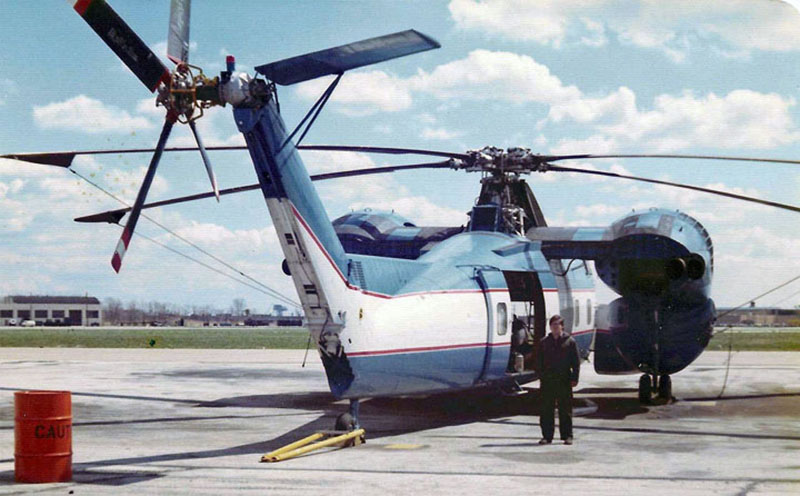
Fuselage
The S-56 fuselage was constructed of an aluminum structure with aluminum and magnesium skins and reinforced plastic or Fiberglas removable panels.
Stabilizer
Three different stabilizer configurations were installed on S-56 helicopters:
Adjustable Stabilizer Early CH-37A helicopters had an adjustable (trim-able) stabilizer on the aft fuselage to aid in maintaining longitudinal trim during forward flight. The stabilizer was adjustable in flight from a 15 degree positive angle to a 10 degree negative angle. For best hovering performance the stabilizer was feathered relative to the main rotor downdraft.
Two Position Stabilizer On later CH-37A and CH-37C models, a two position stabilizer was installed on the aft fuselage. In the flight position it was positioned horizontally with a 2 degree nose down position and in the hover position it dropped to a vertical free floating position in the main rotor downwash with a hydraulic damper to reduce vibration.
Tail Rotor Pylon Stabilizer On CH-37B models the stabilizer was moved to the top of the tail rotor pylon on the right side. This 24.5 sq. ft. stabilizer had 10 degrees of dihedral and a zero degree angle of incidence.
Main Rotor Assembly
A 5 bladed fully articulated main rotor head with a 24 inch offset flapping hinge was installed on the S-56 helicopter. The 72 foot diameter main rotor was controlled by a 2 stage hydraulic irreversible servo control system. On CH-37B and CH-37C helicopters Automatic Stabilization Equipment (ASE) with an auxiliary servo was installed to permit safer night flying and instrument flight. A rotor flapping restrainer allowed rotor engagement in winds of up to 60 knots with the helicopter headed into the wind. Normal operating range for the main rotor was between 164 rpm (618 ft. per sec.) and 204 rpm (769 ft. per sec.).
Six Bladed Main Rotor
In March 1959, a six bladed main rotor was test flown on an Army H-37A helicopter to investigate the flight characteristics. Although the tests indicated lower vibration levels, an appreciable delay in blade stall, and no increase in power requirements it was never used on the S-56 helicopter. However, the six bladed main rotor was used on the S-64 (CH-54A) helicopter.
Main Rotor Blades
The all metal main rotor blades were constructed of aluminum alloy except for steel cuffs. The main rotor blade was constructed of a hollow extruded aluminum spar with 27 honeycomb filled, aluminum skinned pockets bonded to the spar. A NACA 0012 airfoil was used. The original main rotor blades had a 21.5 inch chord with 14 degrees of negative twist and weighed 335 pounds. Wide chord blades with a NACA 0010.9 airfoil, a 23.65 inch chord, and 8 degrees of negative twist were offered on a retrofit basis which provided increased lift and an increase in Maximum speed from 110 to 130 knots on the CH-37C and 80 to 120 knots on the CH-37B. The wide cord blades weighed 350 pounds. The wide chord blades were the first use of an airfoil other than the NACA 0012 on a production Sikorsky helicopter.
Stall Indicator/Performance Indicator
A stall indicator later called a performance indicator was mounted on the top of the instrument panel to assist the pilot in obtaining optimum performance from the helicopter. This was accomplished by a transducer mounted within the piston of the right lateral main rotor servo which measured the vibratory loads imposed on the stationary star (swashplate). The vibratory loads on the stationary star were influenced by varying conditions of rpm, gross weight, altitude, temperature, load factor, airspeed, and fuselage attitude. These loads were a direct indication of the onset of blade stall or the degree of blade stall encountered during a flight. By September, 1960, the stall indicator had been removed from the Marine CH-37C helicopters.
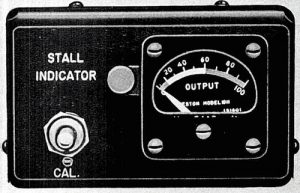

Main Gearbox
The main gearbox consisted of magnesium housing with a 2-stage planetary reduction system plus a spiral bevel input gear mesh for each engine input which all together provided a reduction ratio of 14.05 to 1. This reduced engine rpm from 2700 rpm to 193 rpm.
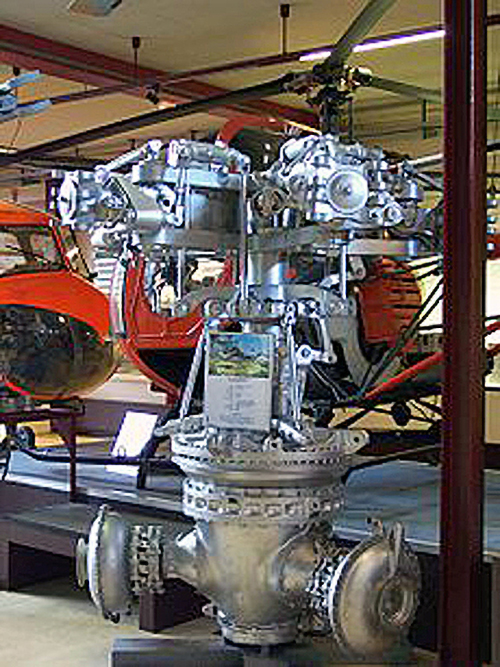
Tail Rotor Assembly
A 4 bladed 15 foot diameter all metal fully articulated tail rotor was installed. To prevent the tail rotor blades from flapping when the helicopter was parked, the tail rotor blades were coned against their stops by an electrically operated coning ring located on the tail rotor gear box. The tail rotor pitch change was accomplished by a 2 stage hydraulic servo.
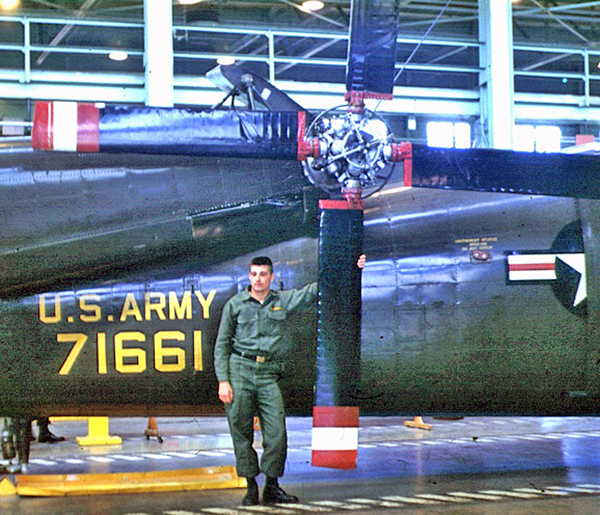
Twin Tail Rotor
In 1956, a Vee shaped twin tail rotor was installed in a Marine XHR2S-1 helicopter to improve the cg (center of gravity) range and to increase forward speed. Both 4 blade and 5 blades twin tail rotors were tested. With two canted tail rotors the individual tail rotor thrusts could be adjusted to provide both the required anti-torque thrust and different levels of lift. In this way if the center of gravity was too far forward or aft it could be compensated for by increasing or decreasing tail rotor lift. The improvements were less than expected and the modifications would increase the complexity of the flight control system and complicate the design solution to the pylon fold requirement.
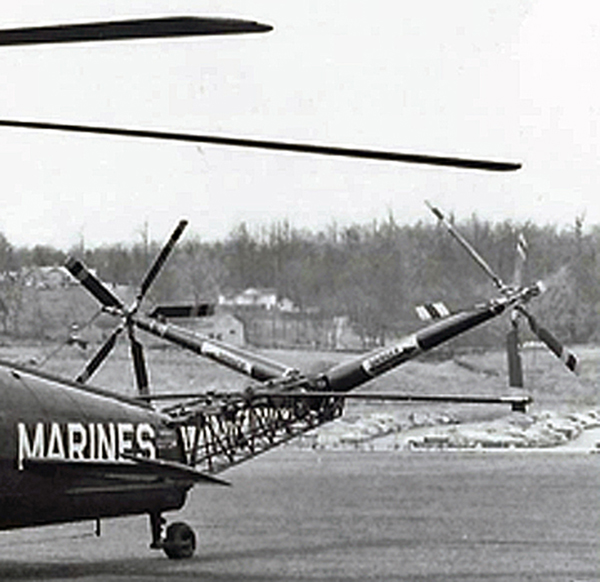
Engine
Two Pratt and Whitney Double Wasp 2100 hp R-2800-54 18 cylinder twin-row engines were installed with a 80 degree turn and a 12 ½ degree upward slope in the drive system to align with the main gearbox input. They were located in a nacelle supported by a stub wing. The engines were plagued by excessive oil consumption until late in its service life when baffles were added to the oil tanks to eliminate oil foaming. The non-standard engine configuration probably contributed to the oil consumption problem. The engines were run at high power settings almost continually which brought a 2,000 hour time between removals in fixed wing applications to 350 hours in a helicopter.
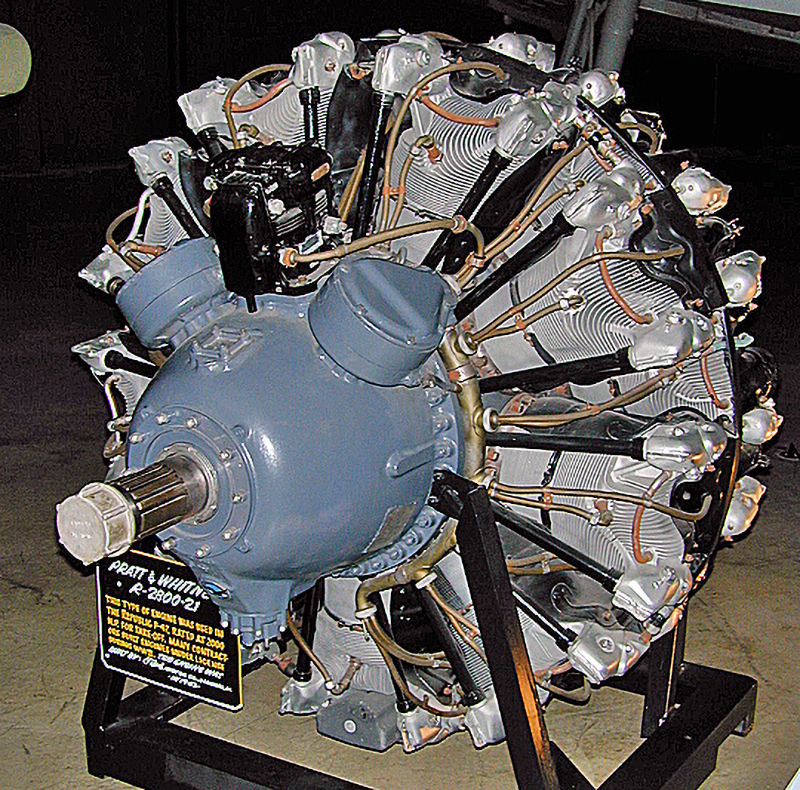
Auxiliary Power Unit (APU)
The S-56 helicopters were equipped with a portable APU which was secured to the rear cabin floor cargo tiedown fittings. The APU used the helicopter battery for starting power or could be hand cranked when necessary. The APU starter-generator was driven by a 10 hp V-2 cylinder gasoline engine. The APU starter-generator provided 28 vdc power primarily to power the cargo winch for helicopter loading. It could also provide power to start the engines and power all electrical equipment installed on the helicopter.
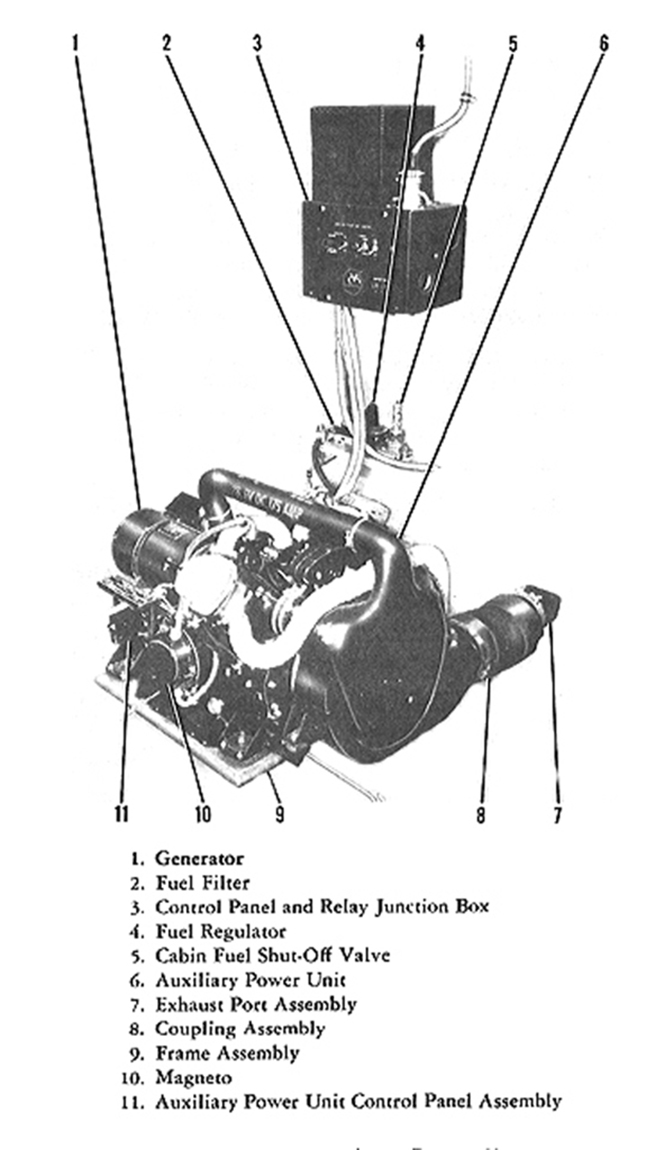
General Arrangement Drawing

Mission Systems
Cargo Hoist
The S-56 helicopters were equipped with a 2,000 lb capacity electric cargo hoist. A monorail on the cabin overhead could be extended out the cabin door to allow self-loading of the helicopter. An Auxiliary Power Unit provided electrical power for loading operations. The cabin floor under the rotor head contained a hatch “Hell Hole” which allowed observation of cargo hook operations and allowed rescue hoist operations (hoist weight was limited to 600 lbs. when hoisting personnel).
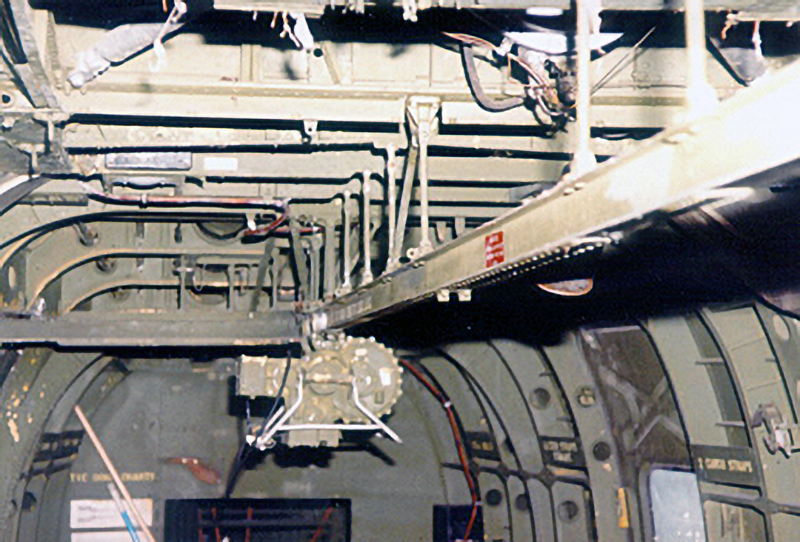
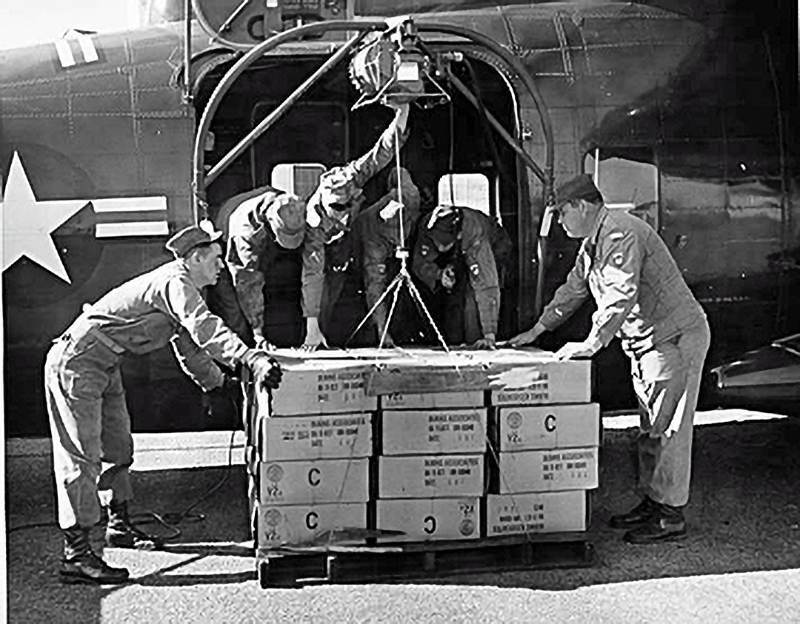
MEDEVAC
The S-56 helicopter could be configured to carry 24 litter patients during a Medical Evacuation mission.
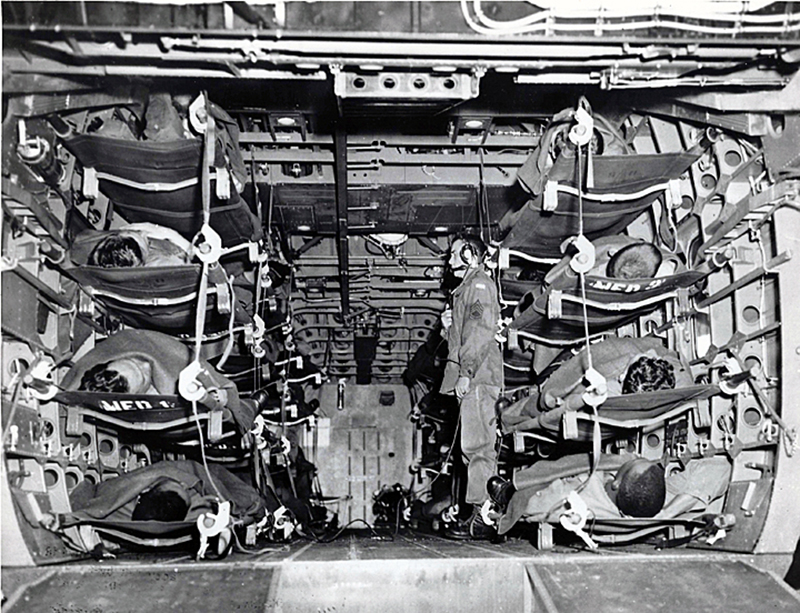
Cargo Hook
A 10,000 pound capacity external cargo sling was available for use on the S-56 helicopter. A crewmember was able to view the external load through cargo hatch in the cabin floor and had a pendant with the ability to drop the load in an emergency.
Troop Accommodations
Troop seats for fully equipped troops were provided for 36 troops in Marine CH-37C helicopters and 23 troops in Army CH-37A/B helicopters.
Mid Air Retrieval System (MARS)
In the 1960s spy satellites ejected film capsules which were captured in mid-air to prevent destruction of the film from a hard landing on earth. Recoveries of packages up to 800 pounds were performed by helicopters. In 1962, White Sands Missile Range identified a need to recover missiles, boosters and capsules using this type of soft recovery. U. S. Army CH-37B was used to recover packages of up to 2,500 ponds.
The technique involved installing a winch and equipment designed by All American Engineering, Wilmington, Delaware. The winch was installed in the cabin forward of the cargo hatch. Two 24 foot arms extended below the helicopter which caught the drogue chute on the package. The main chute was then jettisoned and the package reeled into the helicopter. The winch was like a giant fishing reel and the cable slipped when the load was applied allowing a controlled deceleration. When the speed of the load and the helicopter were matched, a brake was applied and the load reeled into the belly of the helicopter.
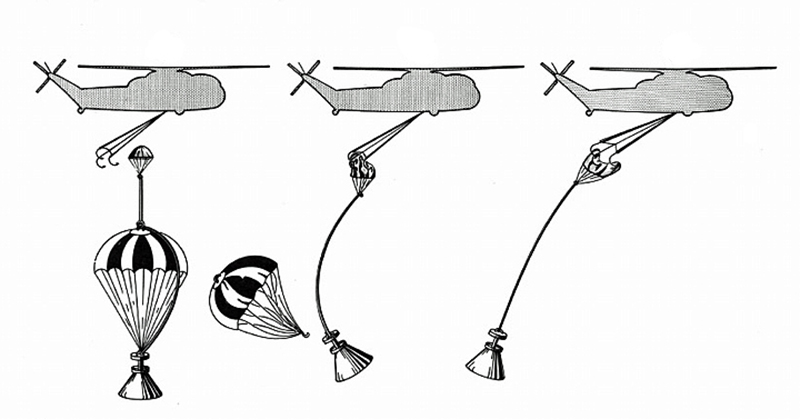
General Characteristics and Performance
Performance Standard Day at Sea Level | |
|---|---|
Maximum Speed (Vne) CH-37C with Wide Chord Blades | 130 kts / 240.8 km/hr
|
Range | 145 miles / 233.4 km
|
Service Ceiling | 8,700 ft / 2651.8 m
|
Rate of Climb | 1,732 ft/min / 8.66 m/s |
Weights | |
|---|---|
Maximum Takeoff Gross Weight | 31,000 lbs / 14061.3 kg
|
Weight Empty | 21,500 lbs / 9752.2 kg
|
Maximum Fuel Load (Internal) | 400 gal / 1514.2 ltr
|
Maximum Fuel Load (External) | 600 gal / 2271.3 ltr
|
Useful Load | 9,500 lbs / 4309.1 kg
|
Maximum External Load ( Cargo Hook) | 10,000 lbs / 4535.9 kg
|
General Data | |
|---|---|
Crew Seating Capacity | 2 |
Seating Capacity | Up to 36 passengers |
Powerplant Ratings Standard Day at Sea Level | |
|---|---|
Pratt and Whitney R2800-54 5 minute rating | 2,100hp / 1544.6 kw |
Aircraft Dimensions | |
|---|---|
Main Rotor Diameter (Blade Tip Circle) | 72’ 0” / 21.9 m
|
Tail Rotor Diameter (blade tip circle) | 15’ / 4.6 m
|
Fuselage Length | 55’ 8” / 16.8 m
|
Length Overall (Including Rotors) | 88’ / 26.8 m
|
Height Overall | 22’ / 6.7 m
|
Main Landing Gear Tread | 19′ 9″ / 5.8 m
|
Production History
Sikorsky Aircraft S-56 production consisted of 156 helicopters.
- 5 U.S. Marine Corps XHR2S-2 prototype helicopters (includes 1 ground only Static Test Article).
- 55 U.S. Marine Corps CH-37C (HR2S-1) helicopters.
- 2 U.S. Navy HR2S-1W Airborne Early Warning (AEW) helicopters
- 94 U.S. Army CH-37A (H-37A) helicopters*
* 90 of the 94 CH-37A helicopters were remanufactured to the CH-37B configuration by Sikorsky Aircraft.
Military surplus S-56 helicopter were sold on the open market. Keystone Helicopters purchased a large number of CH-37B and CH-37C helicopters and operated them under the Air Cranes subsidiary.
Related Models
Westland License
Westland Helicopters Ltd. of Yeovil, England added a license to build the Sikorsky S-56 helicopters to their existing license with Sikorsky Aircraft. No S-56 helicopters were built under license. Westland did use the dynamic components from the S-56 to build a turbine powered model, the Westminster.
Westland Westminster
Using private funding, Westland developed a heavy lift transport with two 2,920 hp Napier Eland E220 turboshaft engines using the dynamic components from the Sikorsky S-56 helicopter. Only 2 were built and the program was cancelled when Westland acquired all their competitors: Saunders-Roe, Bristol, and Fairey. Since the Fairey Rotodyne was already flying and UK Government funded Westland cancelled the company funded Westminster program.
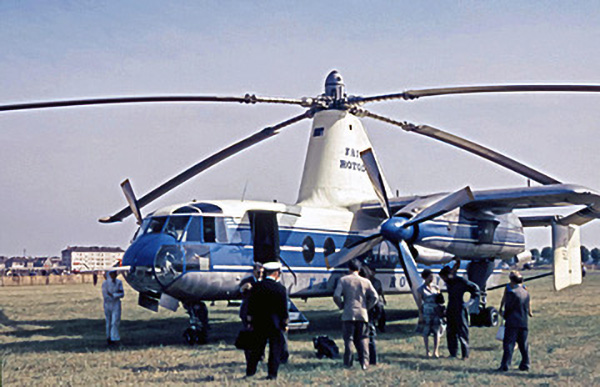
The first Westminster WG.6 was an engineering test bed with a skeletal airframe with the crew cockpit forward. First flight was June 15, 1958. After initial test flights the 5 blade main rotor was replaced by a Sikorsky-supplied six blade main rotor. The second Westminster prototype’s first flight was on September 4, 1959. The program was cancelled in September 1960.
Additional Information
Restored S-56 helicopters can be found on display at the following locations.
Location | S-56 On Display |
|---|---|
Pima Air & Space Museum, Tucson, AZ
| CH-37B Army Ser. No. 56-1005
|
U. S. Army Aviation Museum, Fort Rucker AL
| CH-37B Army Serial No.55-0644
|
National Naval Aviation Museum Pensacola, FL
| CH-37C Navy BuNo 145864
|
Evergreen Aviation & Space Museum, McMinnville, OR
| CH-37B Army Ser. No. 58-0999
|
U. S. Army Transportation Museum, Fort Eustis, VA
| CH-37B Army Ser. No. 57-1651
|
- by Vinny Devine
Related Articles

Sikorsky Builds Big – the S-56
The large and powerful Sikorsky S-56 was Sikorsky’s answer to the U.S. Marine Corps’ request for a shipboard helicopter that could carry heavy loads on amphibious assaults.
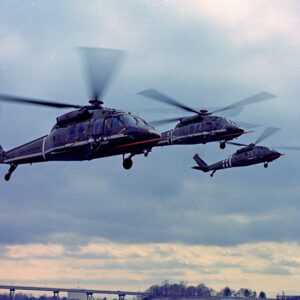
Bill Paul: Reflections on Sikorsky’s 100th Anniversary
Former Sikorsky President Bill Paul reflects on his career with Sikorsky, meeting Igor Sikorsky, and the Sikorsky Aircraft Company’s 100th anniversary.
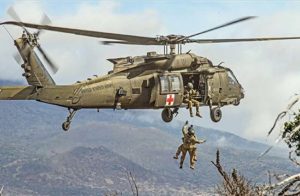
Sikorsky Lifts the Army
The U.S. Army saw the possibilities of the helicopter early in its development, thus beginning a relationship with Sikorsky Aircraft that continues to this day.
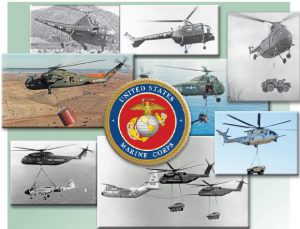
Sikorsky Builds Marine Corps Heavy Lift
The evolution of the Marine Corps’ CH-53K King Stallion heavy lift helicopter beginning with the Sikorsky S-56 in 1953.
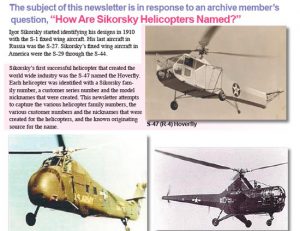
How Sikorsky Helicopters Are Named
The subject of this newsletter is in response to an archive member’s question, “How Are Sikorsky Helicopters Named?”
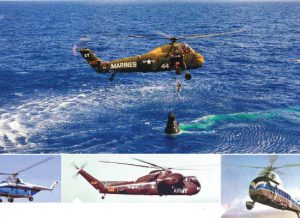
Sikorsky Aircraft in the 1950s
The first Sikorsky large cabin single main rotor helicopter configurations evolved during the 1950s.

